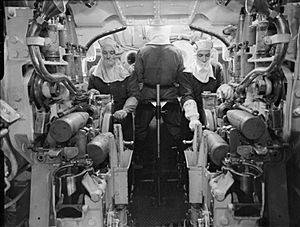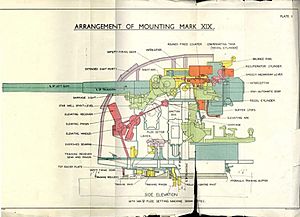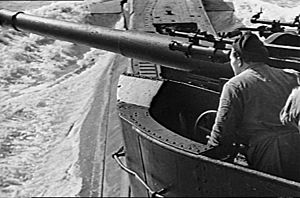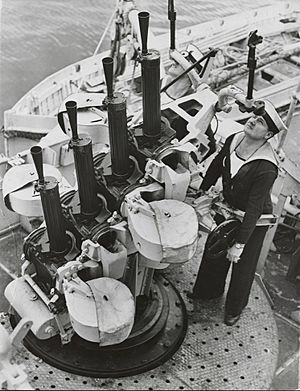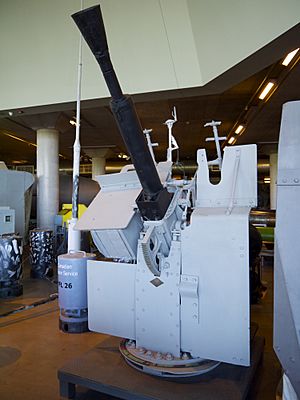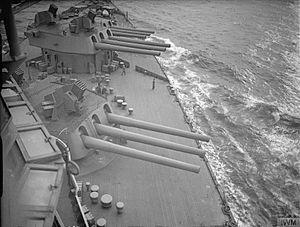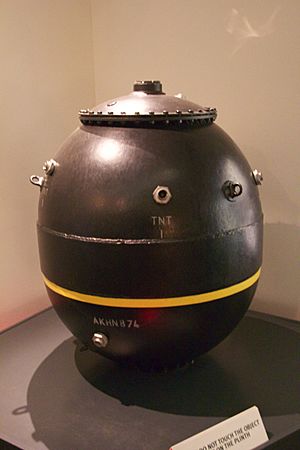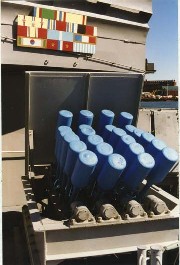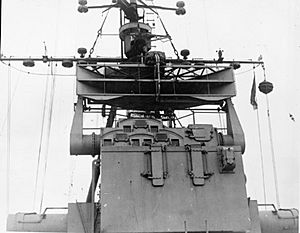List of British naval forces military equipment of World War II facts for kids
The Royal Navy was the main naval force of the United Kingdom during World War II (1939-1945). They played a super important role in protecting shipping lanes, fighting enemy ships, and supporting land invasions. To do all this, they needed lots of different military equipment, from huge guns on battleships to special weapons for hunting submarines. This list shows some of the cool gear the British Navy used during the war.
Contents
Big Guns for Warships
These were the main weapons on the Royal Navy's biggest ships. They could fire huge shells many miles!
Battleship and Monitor Guns
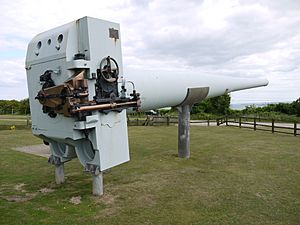
- BL 14-inch Mk VII: These massive guns were only found on the powerful King George V-class battleships.
- BL 15-inch Mk I: A very famous and reliable gun used on many older battleships and battlecruisers.
- BL 16-inch Mk I: The biggest guns on British battleships, only fitted to the Nelson-class ships.
Heavy Cruiser Main Guns
- BL 7.5-inch Mk VI: Used on some older heavy cruisers.
- BL 8-inch Mk VIII: The standard main gun for British heavy cruisers.
Cruiser and Battleship Secondary Guns
These guns were used as the main weapons on lighter cruisers and as secondary guns on battleships. They could also often shoot at aircraft!
- QF 4-inch Mk V: A versatile gun used on many different types of ships.
- QF 5.25-inch Mk I: This was a "dual purpose" gun, meaning it could fire at both ships and aircraft. It was used on King George V-class battleships and Dido-class cruisers.
- BL 6-inch Mk XII, Mk XXII, Mk XXIII: Different versions of the 6-inch gun, commonly used as the main armament on light cruisers.
Guns for Smaller Ships
These guns were fitted to destroyers, frigates, and other smaller warships.
British-Made Guns
- QF 6-pounder 10 cwt: A smaller gun, often used on patrol boats and some destroyers.
- QF 12-pounder 12 cwt: Another common gun for smaller ships.
- QF 4 inch Mk IV, Mk XVI, Mk XIX: Different versions of the 4-inch gun, widely used on destroyers and escort ships.
- BL 4-inch Mk IX: Another 4-inch gun, often used for anti-submarine warfare.
- QF 4.5-inch Mk I – V: A powerful gun used on many destroyers.
- BL 4.7-inch Mk I & II, Mk IX & XII, Mk XI: Various types of 4.7-inch guns, which were the main weapons for many British destroyers.
US Guns (Lend-Lease)
During the war, the UK also received equipment from the United States through agreements like Lend-Lease and the Destroyers-for-bases deal.
- 3-inch/50 calibre gun: A medium-sized gun from the US.
- 4-inch/50 calibre gun: Another US-made gun used by the Royal Navy.
Submarine Guns
Submarines also had guns, usually on their deck, for fighting smaller ships or targets on land.
- QF 4-inch Mk XII and Mk XXII: These were common guns found on British submarines.
Armed Boat Guns
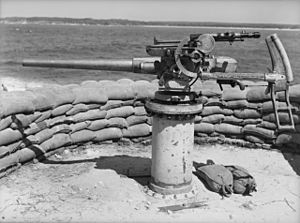
Even small patrol boats and motor torpedo boats carried weapons.
- QF 3-pounder Hotchkiss: A light gun, good for smaller targets.
- QF 6-pdr Class M Mark I with Auto Loader Mk III: A special 6-pounder gun with an automatic loader, making it fire faster.
Anti-Aircraft Guns
These guns were designed to shoot down enemy aircraft.
Machine Guns
- Lewis gun: A light machine gun, often used for close-range defense.
- Vickers .50 machine gun: A heavier machine gun, capable of firing more powerful bullets.
Autocannons
Autocannons are like very fast-firing, small cannons.
- QF 2-pounder Mk I and Mk VIII: Also known as the "pom-pom," this was a very common anti-aircraft gun on British ships.
- Oerlikon 20 mm cannon: A Swiss-designed gun, produced under license in Britain, known for its rapid fire.
- Bofors 40 mm Automatic Gun L/60: A Swedish-designed gun, also built in Britain, famous for being one of the best anti-aircraft guns of the war.
Anti-Aircraft Artillery
These were larger guns specifically designed to hit aircraft at higher altitudes.
British-Made
- QF 3-inch 20 cwt: A common medium-range anti-aircraft gun.
- QF 4.7-inch Mk VIII: A larger anti-aircraft gun, often found on battleships and cruisers.
US-Made (Destroyers-for-Bases Deal)
- 3-inch/23 calibre: A US anti-aircraft gun received by the Royal Navy.
Other Anti-Aircraft Weapons
- Holman Projector: An unusual anti-aircraft weapon that used steam to launch grenades.
- Unrotated Projectile: An early type of anti-aircraft rocket, designed to create a barrage of explosives in the sky.
Torpedoes
Torpedoes are self-propelled underwater weapons that explode when they hit an enemy ship.
- 18-inch torpedoes Mk VIII-XVII: Various versions of the 18-inch torpedo, used on many different ships.
- 21-inch torpedo Mk II-XI: The standard torpedo size for most British destroyers and cruisers.
- 24.5-inch torpedo: A very large torpedo, only fitted to the Nelson-class battleships.
Naval mines are explosive devices placed in the water to damage or sink enemy ships that pass over or near them.
- Mark XVII contact naval mine: This was the main type of contact mine used by the British during World War II.
Anti-Submarine Weapons
These weapons were crucial for finding and destroying enemy submarines, especially during the Battle of the Atlantic.
Depth Charges
Depth charges are barrel-shaped bombs that are dropped into the water and explode at a set depth, hoping to damage or destroy a submarine.
- Mark VII depth charge: The most common type of depth charge.
- Mark VII Heavy: A more powerful version.
- Mark VII Airborne DC, Mark VIII Airborne DC, Mark XI Airborne DC: Depth charges designed to be dropped from aircraft.
- Mark X, X*: Other types of depth charges used.
Anti-Submarine Projectile Launchers
These launchers fired projectiles forward from the ship, rather than dropping them off the back.
- Hedgehog: This weapon fired a pattern of small bombs ahead of the ship, which exploded only if they hit the submarine.
- Squid: A three-barrelled mortar that fired large anti-submarine bombs ahead of the ship.
Radar (Radio Detection And Ranging) was a new technology during WWII that used radio waves to detect ships and aircraft, even in the dark or bad weather. It was super important for finding enemies and aiming guns.
- For more details, see List of World War II British naval radar.
Small Arms
Even sailors on ships needed personal weapons for close-quarters combat or boarding actions.
- Lanchester submachine gun: A 9mm submachine gun, similar to the German MP 28, used by the Royal Navy.


